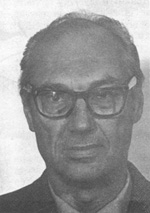Arthur Roberts: Musical Physicist

Dr. Arthur Roberts
The two cultures -- science and the humanities -- are meeting in many ways in the development of NAL.
For example, Arthur Roberts, a physicist in Experimental Facilities at NAL, also is a professorial lecturer in Physics at the University of Chicago. There, he instructs a class called "The Physical Basis of Music." It explores the sound, physics and the psychology of hearing in both musical and scientific terms.
As a special project, Roberts' students are creating their own musical works - and submitting them to a one-man orchestra - the computer.
Someone asked:
"A symphony based on physics, logarithms, trigonometry - and performed by a computer?"
It may be the most exciting musical style of the future, according to Roberts.
Roberts, who holds a degree from the Manhattan School of Music and a Ph.D. in physics from New York University, said:
"Computer-produced music offers the composer unlimited horizons. Many of my students have been able to write original pieces or to translate Telemann, Bach, and Brahms by programming the computer. What distinguishes the computer is its ability to produce as unlimited range of sounds.
"For instance, the computer can produce tones no conventional instrument can, such as a 22-tone scale, or a 29-tone scale. It also possesses an infinite variety of tone qualities and a flawless technique."
Roberts offered interested students extra classes to teach them computer programming for the ORPHEUS music-generating program. After eight hours of lessons, they began to write their own pieces, and then fed their compositions into a computer at the Atomic Energy Commission's Argonne National Laboratory.
"Interestingly enough," Roberts said, "out of 12 students taking the course, only two are music majors, the rest coming from six other fields. The students in the sciences seem to be the most enthusiastic computer composers."
Roberts lectures his students on musical acoustics, which includes "the physical descriptions of musical sounds, the nature and characteristics of auditory perception and the relations between them."
Roberts and his students also study briefly the anatomy and physiology of the ear and its role in sound perception.
He explained, "Some of the questions we discuss are, `what's the softest sound you can hear as a function of frequency?' or 'How many different pitches can be distinguished by the ear?' The answers to such questions affect the nature of new musical instruments and the kind of musical effects perceptible to the ear."
Another feature of the course is an analysis of the structure and operation of musical instruments to determine their effects on sound.
Although musical acoustics is a common subject at most universities, he said, "Our course is unique in its scope, because it offers the student an opportunity to put his knowledge into practice by composing music. I'm hoping some of my students will continue to perfect their technique so that they will be able to produce complete compositions or performances."
He compares the computer's musical output to that of a "sound synthesizer," which is the most frequently used source of electronic music. "However," he added, "computers are much more flexible than any synthesizer currently employed in the recording studio."
Roberts has written a number of musical compositions, most notably, An Overture for the Dedication of a Nuclear Reactor, performed by the Rochester, New York, Philharmonic in 1952.


